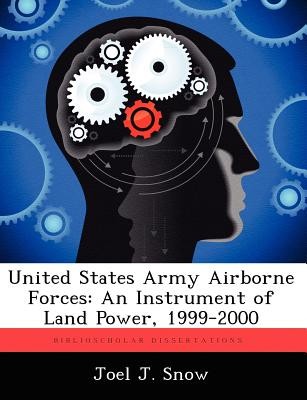
- We will send in 10–14 business days.
- Author: Joel J Snow
- Publisher: BiblioScholar
- ISBN-10: 124942853X
- ISBN-13: 9781249428534
- Format: 18.9 x 24.6 x 1 cm, softcover
- Language: English
- SAVE -10% with code: EXTRA
Reviews
Description
This study critically analyzes the future roles of United States Army airborne forces as an instrument of national security policy during the period 1990-2000. A key to that analysis is the relationship of the strategic roles of airborne forces to requirements of those forces at the operational and tactical levels of war. Conducted from a doctrinal perspective, the study examines the historical basis for the American use of airborne forces. That examination reveals an American tradition of using airborne forces in tactical (versus operational or strategic) roles. The author shows that that tradition will likely influence the future American use of its airborne forces. After describing the strategic, operational, and tactical nature of future conflicts during the target period (1990-2000), a feasible set of roles and missions for US Army airborne forces is presented. Each of the three levels of war is discussed, with emphasis on the operational level. Four illustrative scenarios are used: high-intensity conflict in Europe (operational role), high-intensity conflict in Europe (tactical role), mid- to high-intensity conflict in the Middle East (operational role), and low-intensity conflict in North Africa (strategic role). To facilitate the potential of airborne forces producing operationally significant battlefield victories, a set of prescriptive requirements for the future is offered. The author stresses a balance between the three elements of the paradigm used -- soldiers, weapons, and doctrine. The analysis reveals that, assigned the proper missions and adequately resourced, United States Army airborne forces can effectively serve as an instrument of national security policy during the period 1990-2000.
EXTRA 10 % discount with code: EXTRA
The promotion ends in 17d.04:13:09
The discount code is valid when purchasing from 10 €. Discounts do not stack.
- Author: Joel J Snow
- Publisher: BiblioScholar
- ISBN-10: 124942853X
- ISBN-13: 9781249428534
- Format: 18.9 x 24.6 x 1 cm, softcover
- Language: English English
This study critically analyzes the future roles of United States Army airborne forces as an instrument of national security policy during the period 1990-2000. A key to that analysis is the relationship of the strategic roles of airborne forces to requirements of those forces at the operational and tactical levels of war. Conducted from a doctrinal perspective, the study examines the historical basis for the American use of airborne forces. That examination reveals an American tradition of using airborne forces in tactical (versus operational or strategic) roles. The author shows that that tradition will likely influence the future American use of its airborne forces. After describing the strategic, operational, and tactical nature of future conflicts during the target period (1990-2000), a feasible set of roles and missions for US Army airborne forces is presented. Each of the three levels of war is discussed, with emphasis on the operational level. Four illustrative scenarios are used: high-intensity conflict in Europe (operational role), high-intensity conflict in Europe (tactical role), mid- to high-intensity conflict in the Middle East (operational role), and low-intensity conflict in North Africa (strategic role). To facilitate the potential of airborne forces producing operationally significant battlefield victories, a set of prescriptive requirements for the future is offered. The author stresses a balance between the three elements of the paradigm used -- soldiers, weapons, and doctrine. The analysis reveals that, assigned the proper missions and adequately resourced, United States Army airborne forces can effectively serve as an instrument of national security policy during the period 1990-2000.


Reviews